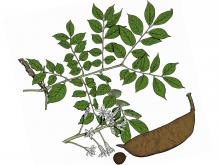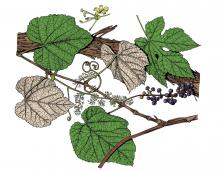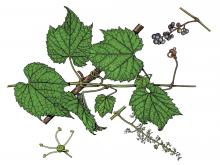Trees, Shrubs and Woody Vines
Media

Species Types
Scientific Name
Gymnocladus dioicus
Description
There’s no mistaking Kentucky coffee tree when its large, tough seedpods are hanging from its limbs or dropping to the ground below. Unpopular as food with today’s wildlife, these seedpods might have fed mastodons and other large, extinct North American mammals.
Media

Species Types
Scientific Name
Quercus palustris
Description
Pin oak is one of the easiest trees to recognize by its shape alone: It has a tall, straight trunk, an overall pyramidal or conical shape and, most notably, the branches on the lower third of the tree angle downward.
Media

Species Types
Scientific Name
Toxicodendron radicans
Description
Poison ivy is a toxic plant that contains an oil in all its parts that, if you come into contact with it, can cause an intense skin reaction. Learn to recognize it, and sidestep it on your outings.
Media

Species Types
Scientific Name
Ceanothus americanus
Description
A very small shrub of our native prairies and other open sites, New Jersey tea was used by patriotic American colonists as a substitute for black tea imported from England during the Revolutionary War.
Media

Species Types
Scientific Name
Smilax hispida (syn. S. tamnoides var. hispida)
Description
Bristly greenbrier is a stout woody vine with bristlelike black spines, climbing high by tendrils to a length of 40 feet. It is the most common greenbrier in Missouri and is found statewide.
Media

Species Types
Scientific Name
Vitis aestivalis
Description
Summer grape is a vigorous, woody, wild grapevine climbing to a height of 35 feet. It grows mostly in the southern two-thirds of Missouri, often in drier situations than many other grape species.
Media

Species Types
Scientific Name
Vitis riparia
Description
Riverbank grape is a woody wild grape vine climbing to 75 feet by means of tendrils. It occurs nearly statewide but is absent from most of the Ozark plateau.
Media

Species Types
Scientific Name
Sambucus canadensis
Description
Common elderberry is a colony-forming shrub with opposite compound leaves. Its large, flattened clusters of small white flowers produce purple or black berrylike fruits.
Media

Species Types
Scientific Name
Rosa multiflora
Description
Starting more than a century ago, this nonnative rose was planted across America — for many good reasons — but multiflora rose has proven to be invasive, and now the goal is to stop its spread.
Media

Species Types
Scientific Name
Rosa setigera
Description
Also called climbing rose, prairie rose is most common near woodlands, where it climbs and trails on neighboring shrubs and small trees.
See Also
About Trees, Shrubs and Woody Vines in Missouri
There are no sharp dividing lines between trees, shrubs, and woody vines, or even between woody and nonwoody plants. “Wood” is a type of tissue made of cellulose and lignin that many plants develop as they mature — whether they are “woody” or not. Trees are woody plants over 13 feet tall with a single trunk. Shrubs are less than 13 feet tall, with multiple stems. Vines require support or else sprawl over the ground.





















